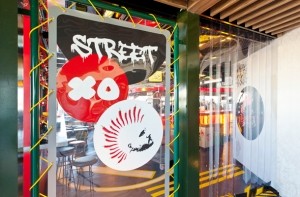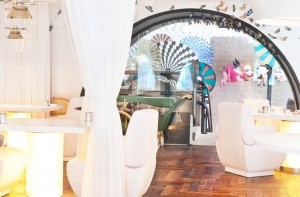Street Smarts: David Muñoz gets ready to open StreetXO in London

This piece was published in the November issue of Restaurant magazine, with the interview held two weeks before the opening of StreetXO.
Intense. That’s the single adjective that comes to mind after spending time with David Muñoz, the self-styled enfant terrible of Spanish gastronomy. “It’s going to be a roller coaster,” he says of his soon-to-open London restaurant. “Like Cirque du Soleil produced by Tim Burton. I want people to be dancing on the tables.”
The 36-year-old chef might serve his cutting-edge dishes with a side order of hyperbole, but this heavily delayed project isn’t the acute case of style-over-substance it first appears. His flagship DiverXO restaurant in Madrid’s Tetuán district has three Michelin stars and StreetXO, a diffusion brand of sorts which, as the name suggests, is inspired by Asian food markets, is one of the Spanish capital’s hippest and most oversubscribed places to eat.
While the London iteration of StreetXO is unlikely to bear any resemblance to a theme park ride or an Alice In Wonderland reboot, it will get noticed when it finally throws open its doors in Mayfair.
At the north end of Old Burlington Street, the basement site is accessed via a ground level door. Hewn from an old shipping container, it bears StreetXO’s distinctive neon branding that depicts its creator’s signature mohawk.
Designed by Spanish designer Lázaro Rosa-Violán, the subterranean space has a moody and industrial look – many of the fixtures and fittings have been salvaged from an old ship – with a lot of black and red and yet more neon.
It’s an edgy offer for this part of town – the team was originally looking at The Endurance pub in Soho, now Alan Yau’s Duck + Rice – but the concept has been tweaked to appeal to the Mayfair crowd by restaurant consultant Paul Weldon Browne, the former operations director of The Arts Club and La Petite Maison. The Madrid iteration of StreetXO is brighter and more casual in feel with obvious references to
hawker markets and the like, while the London site is slicker with more of a late-night vibe.
Alternative attitude
For the two hours we’re with him, a camera crew records Muñoz’s every move for a documentary about the launch of his first restaurant outside of Spain. It’s not difficult to see why he has captured the media’s attention.
The youngest chef in Spain to have achieved three stars (he narrowly beat Eneko Atxa by obtaining Michelin’s maximum rating aged 34), Muñoz has set himself apart from the rest of his country’s culinary firmament with his punk-like persona and by largely looking beyond Spain for inspiration.
His flagship is about as irreverent as a three-star restaurant gets. The chefs serve dishes at the table directly from the pans they use at the stove, and the alternative-looking waiters and waitresses even serve some dishes directly into diners’ mouths.
Muñoz is widely credited with putting the Spanish capital back on the gastronomic map. While Madrid still lags behind Barcelona and San Sebastián when it comes to Spanish food, he and a handful of other young, inventive, chefs have carved out a niche in forward-thinking global cooking and in doing so have almost single-handedly reinvigorated the city’s restaurant scene.
He says he never misses a service at DiverXO – which is open Tuesday through Saturday – and will cook at the London StreetXO all day Sunday and Monday. No days off for him, then. This proposed schedule might sound far-fetched, but after approximately one minute in his company, it is entirely believable. In fact it is difficult to imagine Muñoz sleeping at all.
This slightly built Spaniard is a fizzing ball of energy. He talks with great speed and conviction and for all the hype of his ‘unique’ cuisine, he is likeable and, at times, even humble.
Though he is sensible enough not to be drawn to comment, he is clearly aware that despite their world-class culinary credentials the two other three-star Spanish chefs operating in London – Elena Arzak and, more recently, the aforementioned Atxa – haven’t exactly set the capital’s dining scene on fire with their restaurants.
Muñoz is adamant he won’t be phoning it in.
“I’m not just lending this place my name or my face,” he says. “I will be here for two full days a week. And I’m not just coming to smile at the customers. I’m going to put my apron on and work with the team here to develop new dishes and cook. If any aspect of StreetXO doesn’t work – and I fully expect there to be problems – I will fix it.”
There’s certainly a lot more at stake than a lucrative management contract. Muñoz has considerably more skin in the game than his other countrymen. Indeed, the project is fraught with risk. The restaurant has been funded mainly by Muñoz’s Spanish customers and – unlike those of Arzak and Atxa – it’s not in a hotel. This, coupled with its glam location in the heart of Mayfair, means that StreetXO has required far more investment and, unlike most hotel restaurants, will need to be consistently busy to stay solvent.
“It’s a bigger investment for us for sure,” Muñoz confirms. “But we want to be free to do exactly what we want with every aspect of the restaurant, from the way it looks to the cooking and the way the staff behave. It’s more risk, for sure, but I’m confident it will work.”
Huge delays have also piled on the financial pressure. The restaurant was initially intended to open in June 2014 but structural problems with the building and latterly issues with power supply have conspired to make this one of the capital’s most delayed openings in recent memory.
London calling
Another good omen is that Muñoz has a stronger understanding of the London market having cooked in the capital for five years in his 20s. During this time, he worked for some of the city’s best-known chefs including André Garrett, Jun Tanaka and Giorgio Locatelli, but far more significant was his time cooking in top-end Asian kitchens, most notably Hakkasan, Nobu and David Thompson’s Nahm before it decamped to Bangkok.
“It all started with a meal at Hakkasan. I think I was working at Orrery under André at the time. Coming from Spain where we don’t have any high-end Chinese restaurants, eating there was a revelation. It wasn’t just the food either. Hakkasan was and still is a landmark Asian restaurant. I was desperate to work there.”
So desperate, in fact, that he fabricated his CV, trumpeting a skill with pastry he didn’t actually have in order to secure the job. At the time, the main kitchen brigade was 100 per cent Chinese. The only positions for non-Chinese people were in the pastry section, and Muñoz had no experience with desserts. “It was a big lie but I just about managed to pull it off,” he recalls. Over time, he managed to persuade the chefs in the main kitchen to show him the ropes. No mean feat given the language barrier and Chinese chefs’ tendency to keep their techniques and recipes to themselves. Muñoz was only permitted to watch at first but was later allowed to help prepare dim sum and wok dishes, but only on his days off.
“It was all so exciting. I’d only ever worked in Mediterranean restaurants before coming to London. Back then, every young Spanish chef wanted to work for chefs like Ferran Adrià, Juan Mari Arzak and Joan Roca cooking modern Spanish food,” he says. “This stuff was new. But to me, going to a restaurant like Nahm was also totally new. I was like ‘fuck, this is sweet, this is savoury, this is spicy, this is sour’. Each bite had everything. It was incredible.”
Just don’t call it fusion…
Neither DiverXO or StreetXO are Asian restaurants, despite both being book-ended by Hong Kong’s famous umami-packed XO sauce (it’s one of the Muñoz’s favourites). Yet it is his familiarity with and aptitude for eastern techniques and ingredients that have set him apart from the rest of Spain’s culinary elite, and he is famed for dishes that combine Iberian ingredients and culinary traditions with those of China and, to a lesser extent, Japan.
He is not a fan of the term fusion, however. In fact he doesn’t appear to want his cooking to be put in any kind of box at all. “It’s unique. It’s David Muñoz food,” he insists. “It’s not fusion. We don’t make a chicken curry with Spanish ingredients or anything like that. It’s food that’s travelling round the world, but we don’t want to replicate anything from any other food culture. What do you call octopus cooked on a robata grill with a mole made from jalapeños, a foam made from potatoes and roasted bone marrow and garnished with fried churros?”
When I suggest that some people will probably still classify it as fusion he doesn’t look too impressed. The mohawk also bristles when I talk about his work in the context of other boundary-pushing Spanish chefs.
“The aim is for every dish to be something completely new. We don’t want to use the same techniques as other kitchens,” he says. “All the time I’m working to make it a unique experience for anyone coming from any part of the world. We don’t have limits. We use techniques from all over the world but we also have ways of cooking that are specific to us. We don’t necessarily use a wok like a Chinese cook would use a wok.”
Refreshingly, there’s very little information about his dishes online or in books, a markedly different approach to the majority of his Spanish peers who have always recorded and shared their work.
“We use a lot of techniques but I don’t like anyone seeing them. When you’re a customer you enjoy the eating, the technique is secondary. I don’t make stuff for the sake of technique. I want the customer to see the plate and say ‘what the fuck is that?’. I’ve never done a book. It’s too early for me. Every chef is writing their own cookbook too soon. I don’t know if I’ll ever publish one.”
The kitchen is enormous, roughly the same dimensions as the dining room, and is arranged into small sections each based around a piece of cooking kit. There are a couple of high-powered wok burners, a large robata grill, planchas, a deep-fat fryer and a combi-oven. Muñoz – who generally favours using traditional kitchen equipment over water baths and the like – says a lot of his ingredients travel around the different sections during service to be cooked. “That’s how we get unusual textures and flavours. I might steam a whole monkfish and then sear it in a wok so it’s almost burnt and very crisp on the outside but amazingly soft in the middle,” he explains.
Menu differences
The long-term plan is for the two StreetXO menus to be completely different but, for practical reasons, the launch menu at the London StreetXO will contain about 40 per cent of dishes that have previously been served at the Madrid StreetXO.
These include some of the restaurant’s most famous creations including Muñoz’s steamed take on a club sandwich – involving ricotta cheese and a fried quail’s egg seasoned with shichimi togarashi – as well as Beijing-style dumplings with crunchy pig’s ear, strawberry hoisin, aïoli and gherkins.
New dishes developed for London include rabbit dumpling with carrot foam and Chinese five spice; and olive salad with courgette flowers.
There will be 20 items on the main menu, which is simply an unstructured list of dishes. The plates are somewhere between a starter and a main course and, Muñoz says, more generous than what are currently being sold as small plates in London. Spend per head is anticipated to be £50-£55 at lunch and £80-£85 at dinner.
Making ends meet
The 25-cover DiverXO famously struggles to turn a profit for the same reason that a lot of other three-star restaurants struggle to make ends meet. Namely huge staff bills as a result of a 1:1 staff-to-diner ratio and equally heart-stopping ingredient costs. But Muñoz’s tendency to rip it all up and start again every year also gives his accountant a headache.
The look of the space is being constantly refreshed and the modern art changes regularly too. The restaurant has also moved location twice since its inception (it started out a very different proposition to what it is today in a run-down neighbourhood with just two chefs at the stove and one waiter).
With its two-hour queue to get in, StreetXO in Madrid certainly does make money. Its London iteration is expected to be busy from day one, and with 30 chefs in the kitchen during service it will certainly need to be. Unlike Madrid, the 100 cover restaurant will take bookings, but the 20 or so covers that run along the kitchen’s huge, snaking counter will be reserved for walk-ins only.
Muñoz says the restaurant’s staffing structure is unusually flat with loosely defined job roles and no obvious hierarchy aside from the two head chefs he has brought over from Spain – Manuel Villalba Martinez and Jhonny Setjosanz (another mohawk wearer) – and general manager Vincenzo Frenda, formerly of Yauatcha. Chefs will serve some of the dishes and front-of-house staff will finish many of the plates tableside and will help the chefs with their mise en place. With staff needing to be knowledgeable about the food to help diners navigate the structureless menu, this unconventional approach makes sense.
Taking StreetXO stateside
Though they are understandably being kept on the down-low at the moment, there are plans afoot for a restaurant in New York. How compatible a project on the other side of the Atlantic will be with his plan to never miss a service at DiverXO and to work two days a week in the UK remains unclear.
And how the London StreetXO will be received is hard to call at the moment, with consultant Weldon Browne already hinting that he thinks it might be a Marmite-like establishment. The top-end Asian food scene in London is light year’s ahead of that of Madrid, and indeed anywhere else in Europe, which means his Asian-influenced cooking probably won’t stand out as much.
Furthermore, overt fusion food – and that is arguably what StreetXO deals in – is not especially fashionable at the moment with the overarching trend being for ‘authentic’ Asian restaurants that serve dishes that, the story goes, could be found in a roadside shack in Thailand or a night market in Singapore.
That said, Muñoz is clearly a prodigious talent. As his first restaurant outside his homeland, there’s a lot riding on StreetXO London and the project will undoubtedly be delivered with an extraordinary amount of energy by him and his team. Muñoz believes he can offer something sufficiently alternative and exciting enough to win London over. He may well be right.






































